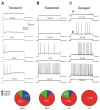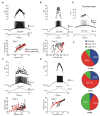Developing electrical properties of postnatal mouse lumbar motoneurons
- PMID: 26388736
- PMCID: PMC4557103
- DOI: 10.3389/fncel.2015.00349
Developing electrical properties of postnatal mouse lumbar motoneurons
Abstract
We studied the rapid changes in electrical properties of lumbar motoneurons between postnatal days 3 and 9 just before mice weight-bear and walk. The input conductance and rheobase significantly increased up to P8. A negative correlation exists between the input resistance (Rin) and rheobase. Both parameters are significantly correlated with the total dendritic surface area of motoneurons, the largest motoneurons having the lowest Rin and the highest rheobase. We classified the motoneurons into three groups according to their discharge firing patterns during current pulse injection (transient, delayed onset, sustained). The delayed onset firing type has the highest rheobase and the fastest action potential (AP) whereas the transient firing group has the lowest rheobase and the less mature AP. We found 32 and 10% of motoneurons with a transient firing at P3-P5 and P8, respectively. About 20% of motoneurons with delayed onset firing were detected at P8. At P9, all motoneurons exhibit a sustained firing. We defined five groups of motoneurons according to their discharge firing patterns in response to ascending and descending current ramps. In addition to the four classical types, we defined a fifth type called transient for the quasi-absence of discharge during the descending phase of the ramp. This transient type represents about 40% between P3-P5 and tends to disappear with age. Types 1 and 2 (linear and clockwise hysteresis) are the most preponderant at P6-P7. Types 3 and 4 (prolonged sustained and counter clockwise hysteresis) emerge at P8-P9. The emergence of types 3 and 4 probably depends on the maturation of L type calcium channels in the dendrites of motoneurons. No correlation was found between groups defined by step or triangular ramp of currents with the exception of transient firing patterns. Our data support the idea that a switch in the electrical properties of lumbar motoneurons might exist in the second postnatal week of life in mice.
Keywords: calcium; dendritic arborization; discharge firing pattern; spinal.
Figures





Similar articles
-
Electrical and Morphological Properties of Developing Motoneurons in Postnatal Mice and Early Abnormalities in SOD1 Transgenic Mice.Adv Neurobiol. 2022;28:353-373. doi: 10.1007/978-3-031-07167-6_14. Adv Neurobiol. 2022. PMID: 36066832 Review.
-
Postnatal electrical and morphological abnormalities in lumbar motoneurons from transgenic mouse models of amyotrophic lateral sclerosis.Arch Ital Biol. 2007 Nov;145(3-4):311-23. Arch Ital Biol. 2007. PMID: 18075124
-
Postnatal changes in the inactivation properties of voltage-gated sodium channels contribute to the mature firing pattern of spinal motoneurons.J Neurophysiol. 2008 Jun;99(6):2864-76. doi: 10.1152/jn.00059.2008. Epub 2008 Apr 9. J Neurophysiol. 2008. PMID: 18400961
-
Dendritic L-type calcium currents in mouse spinal motoneurons: implications for bistability.Eur J Neurosci. 2000 May;12(5):1635-46. doi: 10.1046/j.1460-9568.2000.00055.x. Eur J Neurosci. 2000. PMID: 10792441
-
Changes during the postnatal development in physiological and anatomical characteristics of rat motoneurons studied in vitro.Brain Res Brain Res Rev. 2005 Sep;49(2):377-87. doi: 10.1016/j.brainresrev.2005.02.003. Epub 2005 Mar 24. Brain Res Brain Res Rev. 2005. PMID: 16111564 Review.
Cited by
-
Brief early-life motor training induces behavioral changes and alters neuromuscular development in mice.PLoS Biol. 2025 Apr 21;23(4):e3003153. doi: 10.1371/journal.pbio.3003153. eCollection 2025 Apr. PLoS Biol. 2025. PMID: 40258043 Free PMC article.
-
Two opposite voltage-dependent currents control the unusual early development pattern of embryonic Renshaw cell electrical activity.Elife. 2021 Apr 26;10:e62639. doi: 10.7554/eLife.62639. Elife. 2021. PMID: 33899737 Free PMC article.
-
Long-Term Cultures of Spinal Cord Interneurons.Front Cell Neurosci. 2022 Feb 7;16:827628. doi: 10.3389/fncel.2022.827628. eCollection 2022. Front Cell Neurosci. 2022. PMID: 35197829 Free PMC article.
-
A dynamic role for dopamine receptors in the control of mammalian spinal networks.Sci Rep. 2020 Oct 2;10(1):16429. doi: 10.1038/s41598-020-73230-w. Sci Rep. 2020. PMID: 33009442 Free PMC article.
-
Kv1.2 Channels Promote Nonlinear Spiking Motoneurons for Powering Up Locomotion.Cell Rep. 2018 Mar 20;22(12):3315-3327. doi: 10.1016/j.celrep.2018.02.093. Cell Rep. 2018. PMID: 29562186 Free PMC article.
References
-
- Amendola J., Gueritaud J. P., Lamotte D’incamps B., Bories C., Liabeuf S., Allene C., et al. . (2007). Postnatal electrical and morphological abnormalities in lumbar motoneurons from transgenic mouse models of amyotrophic lateral sclerosis. Arch. Ital. Biol. 145, 311–323. - PubMed
-
- Bennett D. J., Li Y., Siu M. (2001). Plateau potentials in sacrocaudal motoneurons of chronic spinal rats, recorded in vitro. J. Neurophysiol. 86, 1955–1971. - PubMed
LinkOut - more resources
Full Text Sources
Other Literature Sources
Research Materials
Miscellaneous

